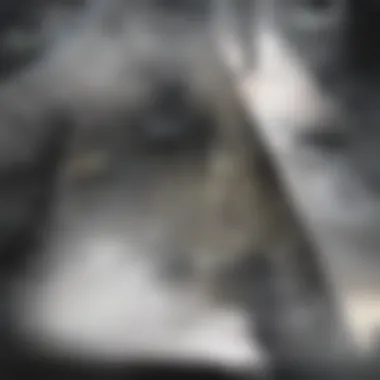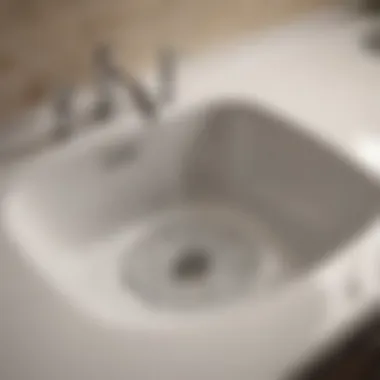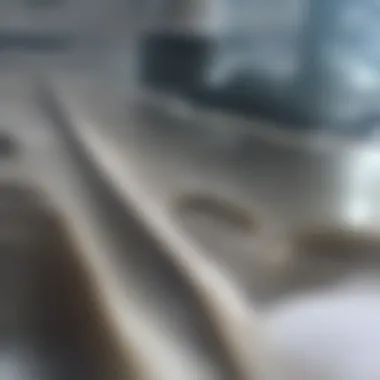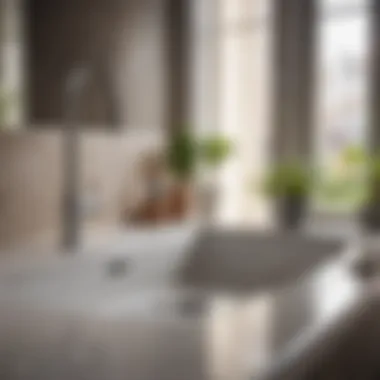Understanding Sink Drainage Issues and Solutions


Intro
Sink drainage issues are a common source of frustration for many homeowners. Understanding the mechanics behind these problems can lead to effective solutions and maintenance strategies. In this article, we will unravel the typical issues associated with sink drainage, such as unpleasant odors, slow drainage, and even complete blockages. Homeowners will benefit from learning how to identify and rectify these problems efficiently.
Moreover, this article not only explores solutions but also emphasizes the importance of preventive measures. By knowing how to maintain sink drainage systems, one can enhance both functionality and lifespan.
The content caters specifically to homeowners and design enthusiasts seeking both aesthetic appeal and functional efficiency in their living spaces. Let's delve into the crucial points surrounding sink drainage issues.
Foreword to Sink Drainage
Understanding sink drainage is essential for maintaining the functionality and aesthetic appeal of a home. Blocked sinks can lead to inconvenient situations, not only disrupting daily routines but also causing potential damage to plumbing systems. By addressing drainage issues proactively, homeowners can save both time and money. This section outlines the significance of effective drainage while highlighting the types of sinks commonly used and their respective drainage mechanisms.
The Importance of Proper Drainage
Proper drainage is crucial in any sink system. A well-functioning drainage system prevents water accumulation and prevents unpleasant odors and bacteria growth. Clogs in the drain can lead to overflows, creating not just an inconvenience but also a risk for water damage to surrounding structures. Regular maintenance ensures that sinks operate efficiently and extend their lifespan. Moreover, understanding drainage helps in troubleshooting minor problems before they become major headaches.
To sum up, the importance of proper drainage cannot be understated. Here are a few key points to consider:
- Prevention of Water Damage: Keeping the drainage system clear helps avoid leaks and potential costly repairs.
- Hygiene: Proper drainage eliminates stagnant water where mold and bacteria can thrive.
- Functionality: A smooth drainage system enhances the usability of the sink, making daily tasks much easier.
Common Sink Types and Their Drainage Systems
Different sinks come with distinct drainage systems designed to handle specific needs. Understanding these systems can help in identifying issues and proper maintenance practices. Here are some common types of sinks:
- Kitchen Sinks: Typically larger and equipped with multiple compartments, kitchen sinks often face unique challenges due to the variety of food particles and grease that can accumulate.
- Bathroom Sinks: Generally smaller and primarily used for personal hygiene, these sinks may experience clogs from hair and soap scum.
- Utility Sinks: Often found in laundries, these sinks are designed to handle heavy use and thus need robust drainage systems to cope with larger debris.
- Bar Sinks: These are smaller sinks often found in entertainment areas. Although they see less heavy use, they can still suffer from clogs due to limited drainage systems.
Understanding the specific drainage mechanisms for each type of sink is essential for effective troubleshooting and maintenance. For instance, a kitchen sink may have a trap and a tailpiece, whereas utility sinks might have different configurations designed to withstand high flow.
Knowing the differences in drainage helps homeowners manage each sink type effectively, leading to a more efficient and functional home.
"A proactive approach to sink drainage can prevent complications that may arise due to neglect."
Identifying Drainage Issues
Identifying drainage issues is crucial for maintaining a functional and efficient sink system. Recognizing the early signs of problems not only saves potential headaches but also leads to timely solutions. Often, small blockages can transform into significant issues if left unattended. Homeowners and interior design fans alike should be vigilant about the performance of their sink drainage. This vigilance prevents larger repairs, and promotes overall home hygiene.
Signs of a Clogged Sink
Clogged sinks present several noticeable signs. The following indicators should raise concern:
- Slow Drainage: One of the most apparent signs of a drainage issue is a sink that takes longer than usual to drain. This often indicates a buildup of debris.
- Unpleasant Odors: Foul smells emanating from the sink can signal decomposing food particles or stagnant water trapped in the pipes.
- Visible Debris: If you can see food or other material sticking around the drain, it is a clear sign that a clog may be forming.
- Water Backing Up: Water that flows back up into the sink instead of draining properly is a strong indicator of a blockage further along the plumbing system.
Recognizing these signs early allows for prompt action, which can mitigate further complications and costs.
Understanding Gurgling and Slow Draining
Gurgling noises from a sink are more than annoying sounds; they are signals of underlying issues. Often, gurgling occurs when air is trapped in the drain system, indicating a partial blockage or inadequate venting. A sink that drains slowly can also suggest that a blockage is forming.
To better comprehend these issues:
- Gurgling Noises: Pay attention to the frequency of the gurgling. If it occurs consistently, it may suggest a need for inspection.
- Slow Draining: Prolonged slow drainage can lead to further complications. If left untreated, it may eventually lead to a complete blockage.
Addressing gurgling or slow draining promptly can prevent a full-scale plumbing failure.


"Recognizing the early signs of sink drainage issues can save you both time and money, ensuring a functional and pleasant living environment."
Typically, problems related to drainage require careful analysis. By observing these signs, homeowners can take proactive measures, preventing bigger issues down the road. Regular monitoring becomes vital to ensuring long-term sink functionality.
Common Causes of Sink Drain Problems
Understanding the common causes of sink drain problems is pivotal in maintaining a functional household. This section will dissect prevalent issues that lead to sink blockages and impaired drainage. Recognizing these causes helps homeowners prevent costly repairs and ensures the integrity of plumbing systems. Conscience maintenance, combined with knowledge of these issues, empowers individuals to sustain their drainage systems effectively.
Accumulation of Food Particles
Food particles are often the main culprits in draining issues. When food scraps are rinsed down the sink, they can accumulate within the pipes over time. This is especially prominent in kitchen sinks where preparation waste is common. Small fragments can stick to the sides of pipes, gradually building up and causing clogs.
To mitigate this, one can implement a simple practice: using a sink strainer. This inexpensive tool will catch solid particles, preventing them from entering the drainage system. In addition, performing regular cleanings by flushing hot water down the drain aids in breaking down any buildup.
Grease Buildup
Grease buildup is a significant contributor to sink drainage problems. When fats and oils are washed down the kitchen sink, they can cool and solidify inside the pipes, leading to blockages. Unlike water, grease does not flow easily, and, over time, it can create a thick coating on pipe walls.
Preventing grease buildup involves avoiding pouring fats down the sink. Instead, using a container to dispose of used cooking oils is more effective. Furthermore, incorporating hot water with dish soap into the routine can help dissolve any existing grease and keep the pipes clear.
Foreign Objects in the Drain
Foreign objects, ranging from small toys to food wrappers, can infiltrate sink drains, causing unexpected clogs. These items often find their way into the disposal system or down the sink during regular use. Once lodged in the pipes, they can obstruct the flow of water and create more serious blockages.
Regularly checking the disposal area and being cautious about what goes down the sink minimizes the risk. In cases where foreign objects create issues, utilizing a plumbing snake to reach deep into the pipes may be necessary to remove the blockage.
Tree Roots Intruding the Pipes
Tree roots intruding the drainage system is a less common but more serious concern. Roots can penetrate cracked pipes, seeking moisture from the sewer system. Once inside, they can lead to significant damage and obstruct normal drainage. This issue is prevalent in older homes with aging plumbing systems.
Homeowners should remain vigilant about their yard’s vegetation and consider root barriers for large plants. If roots are suspected within the pipes, professional assistance is often required. Advanced equipment can detect and eliminate roots, restoring optimal drainage functionality.
Recognizing the various causes of sink drainage problems is crucial for effective maintenance. Through consistent practices and insightful prevention methods, one can ensure smooth drainage and prolong the life of plumbing systems.
Diagnosing the Problem
Diagnosing the problem is a critical step in understanding sink drainage issues. Without a precise diagnosis, remedies may be ineffective or even exacerbate the situation. Homeowners must recognize that each drainage problem is unique. Thus, thorough diagnosis is essential to identify the particular cause behind blockages or slow drainage. This process involves assessing symptoms, analyzing potential causes, and selecting appropriate solutions. Here are some reasons why diagnosing the problem is essential:
- Proper identification leads to effective solutions.
- Prevention of future drainage issues can be based on diagnostics conducted.
- Understanding specific drainage symptoms can save time and resources.
An equipped homeowner can tackle drainage problems with confidence. Hence, it is crucial to assess tools and methods involved in diagnosis.
Tools Needed for Diagnosis
When diagnosing sink drainage problems, several tools can facilitate the process. These tools help in understanding the nature of the issue and provide accurate results. Some common tools include:
- Plunger: Useful for minor clogs and evaluating how deep the blockage might be.
- Drain snake: This tool can reach deeper clogs invisible to the naked eye.
- Flashlight: Helpful for inspecting dark areas under sinks or inside pipes.
- Wet/dry vacuum: This can be beneficial to remove debris easily.
- Pipe inspection camera: Provides a visual insight into the pipes, identifying cracks or severe blockages.
Knowing how to use these tools effectively can greatly assist in precise diagnosis of kitchen or bathroom sinks.
Step-by-Step Diagnosis Procedure
Diagnosing a drainage issue requires a systematic approach. A clear procedure helps in pinpointing the problem accurately. Here are the steps to follow:
- Observe Symptoms: Review symptoms such as slow draining, gurgling noises, or unpleasant odors. These signs provide initial insight into the issue.
- Check the P-Trap: Examine the P-trap under the sink for clogs. This curve in the pipe generally collects debris.
- Use a Plunger: Start by using a plunger to see if this immediate action resolves any apparent clogs. Ensure you create a tight seal.
- Inspect with Flashlight: If the clog persists, shine a flashlight into the drain or pipe area. Look for noticeable blockages.
- Employ Drain Snake: Use the drain snake to reach deeper clogs. Feed it slowly to fetch debris without causing pipe damage.
- Utilize a Wet/Dry Vacuum: If you can access the drain, employ a wet/dry vacuum to remove trapped material beyond reach.
- Camera Inspection (if necessary): If issues remain unresolved, consider using a pipe inspection camera to understand internal pipe conditions.


This structured diagnosis will not only identify the issue but will also allow homeowners to decide on the best course of action.
"Most plumbing issues stem from improper diagnoses, leading to costly repairs. Accurate inspection is the first step towards effective solutions."
By following these recommendations, one can return their sink to optimal functionality.
Effective Solutions for Sink Drain Issues
Addressing sink drainage issues effectively is crucial for maintaining a functional home environment. This section delves into practical solutions that homeowners can implement to resolve common drainage problems. Each method is designed to be accessible, allowing individuals to take control of their maintenance tasks without always resorting to professional help. By understanding these solutions, you can save time, prevent future issues, and ultimately enhance your home’s overall efficiency.
Using a Plunger
The plunger is perhaps the most recognizable tool when it comes to dealing with sink blockages. Its design allows for a concentrated force that can dislodge clogs situated in the drainpipe. To use a plunger effectively, ensure that you have one designed for sinks, as they differ slightly from those meant for toilets.
- Prepare the Area: Clear any water from the sink as much as possible. This will help the plunger create a tight seal.
- Seal the Overflow Drain: If your sink has an overflow drain, cover it with a wet cloth to prevent air from escaping.
- Plunge: Position the cup over the drain and apply firm, consistent strokes. Start slowly to create suction, and then increase your speed.
- Rinse: After a few minutes, remove the plunger. Flush the sink with hot water to check if the blockage has cleared.
Using a plunger can often provide immediate relief for minor clogs without any chemicals.
Applying Baking Soda and Vinegar
Baking soda and vinegar are household items that create a simple yet effective remedy for sink drainage issues. This method works well for minor clogs and promotes a cleaner drainage system without harmful chemicals.
- Initial Rinse: Pour hot water down the drain to help loosen debris.
- Add Baking Soda: Measure about half a cup of baking soda and pour it into the drain. Allow it to sit for several minutes.
- Introduce Vinegar: Follow with half a cup of vinegar, which will react with the baking soda to create fizz. This reaction can help break down organic matter.
- Let It Sit: Allow the mixture to sit for at least thirty minutes. Rinse with hot water afterward.
This method may require repetition for stubborn clogs, but is safe and eco-friendly.
Using a Drain Snake
For more persistent clogs, a drain snake may be necessary. This tool consists of a long, flexible auger that can reach deep into your pipes. Here’s how to use one effectively:
- Insert the Snake: Feed the head of the snake into the drain until you feel resistance. This indicates you have reached a clog.
- Rotate the Handle: Turn the handle on the snake to break up or latch onto the blockage. Pull out any debris that may come up.
- Cleaning Up: After clearing the clog, run hot water through the drain to help remove any remaining particles.
Utilizing a drain snake can be a bit labor-intensive, but it is an effective solution for tougher drain problems.
Chemical Drain Cleaners: A Caution
While chemical drain cleaners can be tempting for quick fixes, they carry significant risks. These products often contain harsh chemicals that can corrode pipes and lead to more serious plumbing issues. They can also be hazardous to breathe and harmful to the environment.
- Consider the Risks: Before using, evaluate if the benefits outweigh the potential damage to your plumbing.
- Choose Wisely: If you must resort to a chemical cleaner, look for biodegradable options. Read labels carefully to minimize harmful effects.
- Alternatives: Always consider other methods mentioned above as safer alternatives.
In summary, while chemical cleaners can offer immediate results, their long-term impact on sink drainage systems merits cautious consideration.
Taking a proactive approach in addressing sink drainage issues will enhance overall home maintenance and functionality. Regular checks and maintenance can often prevent the need for more drastic measures.
When to Call a Professional
Dealing with sink drainage issues can be a routine part of home ownership. However, there are instances where the problems exceed DIY solutions. Understanding when to call a professional is crucial to avoid exacerbating a seemingly simple issue.
A professional plumber brings expertise and specialized tools that enable them to handle complex problems efficiently. This can save homeowners both time and money, as ineffective DIY attempts can lead to further damage. Assessing the situation clearly can prevent unnecessary repairs or replacements.
Signs Indicating Professional Help is Needed
Recognizing the signs that indicate you need professional assistance can prevent minor issues from escalating into major problems. Here are some key indicators:
- Persistent Clogs: If simple fixes, like plunging or using a drain snake, do not resolve the clog after several attempts, it’s time to seek help.
- Recurring Blockages: Multiple instances of blockages in a short period can hint at deeper plumbing issues, such as damaged pipes or tree root interference.
- Unpleasant Odors: Foul smells emanating from the sink area might indicate stagnant water or decaying material within the pipes.
- Leaks and Water Damage: If you notice wetness under the sink or water stains on nearby surfaces, a leak could signify serious plumbing problems that require immediate attention.
- Gurgling Sounds: If your sink gurgles periodically, this might mean there is a venting issue or blockage in the drainage system.


Ignoring these signs can lead to higher repair costs in the long run. When in doubt, consulting a qualified professional can provide clarity and peace of mind.
Choosing the Right Plumber
Selecting a well-qualified plumber is as critical as knowing when to call for help. Here are some tips to ensure you choose the right expertise for your specific needs:
- Verify Credentials: Ensure the plumber holds the necessary licenses and insurance to operate in your area. This protects you in case of accidents during repairs.
- Check Reviews and References: Look online for reviews on sites like Reddit or Facebook. Past customers can provide valuable insights into the plumber's reliability and quality of work.
- Get Multiple Quotes: Obtaining estimates from several plumbers allows you to compare not just prices, but also services offered. Be cautious of bids that seem too low; they may reflect subpar work.
- Ask About Warranty and Guarantees: A reputable plumber often stands by their work and offers warranties on repairs. This ensures you won’t face unexpected costs in the near future.
- Discuss the Problem Thoroughly: Before any work begins, explain the issue clearly. A plumber who takes the time to listen and understand your problems is likely more dedicated to solving them.
By closely evaluating your circumstances and selecting the right professional, you can ensure that your sink drainage issues are effectively addressed, restoring functionality and peace of mind in your home.
Preventative Measures for Drain Maintenance
Preventative measures for drain maintenance are crucial to ensure the optimal functionality and longevity of sink drainage systems. Regular upkeep minimizes the potential for significant clogs and costly repairs down the line. A proactive approach helps in identifying minor issues before they escalate, preserving both the efficiency and the aesthetic integrity of the kitchen or bathroom sink.
Regular Cleaning Routines
Implementing regular cleaning routines is one of the simplest yet most effective methods to maintain clear drains. Homeowners can establish a monthly schedule that includes both everyday cleaning and deeper maintenance tasks. Simple actions such as flushing the sink with hot water after each use can dissolve grease and food residues. Additionally, using a mix of baking soda and vinegar periodically can enhance the cleaning process.
- Daily: Rinse the sink with hot water after use.
- Weekly: Clean sink surfaces and hardware to prevent buildup.
- Monthly: Use baking soda and vinegar to flush the drain.
These routines not only keep the sink clean but also prevent accumulations that lead to clogs. By maintaining this discipline, one can significantly reduce the risk of serious drainage problems.
Proper Disposal of Waste
Understanding how to dispose of waste correctly is vital for preventing drainage issues. Many homeowners underestimate the impact of improper waste disposal. Common kitchen habits can lead to blockages over time if not managed properly. For example, food scraps, grease, and even coffee grounds should not be disposed of through the sink. Instead, these items should be collected and placed in the trash or composted.
Practicing proper disposal can involve:
- Using a Waste Bin: Always use a designated waste bin for food scraps and non-biodegradable items.
- Installing a Garbage Disposal Unit: If suitable, consider installing a garbage disposal that is designed for food waste. However, it is still important to follow guidelines on what can be processed safely.
Educating all household members about proper disposal practices can greatly reduce the likelihood of drainage issues.
Using Drain Screens
Installing drain screens is an effective, cost-efficient strategy to prevent debris from entering the drainage system. These screens capture hair, food particles, and other materials that would otherwise contribute to clogs. They are simple devices that fit over the drain opening, making them easy to install and clean.
To make the most of drain screens:
- Select High-Quality Screens: Choose durable materials that can withstand regular use.
- Regularly Empty and Clean: Make it a habit to check and clean drain screens at least once a week. This prevents overflowing and ensures that they function correctly.
Implementing these two preventive measures can hugely increase the effectiveness of your drainage system while minimizing maintenance efforts.
Proper maintenance extends the life of your sink and enhances overall home functionality.
By emphasizing preventative measures, homeowners can enjoy a smooth-running sink while avoiding the inconveniences and costs associated with clogged drains.
Finale and Summary
In this article, we have explored the significance of understanding sink drainage issues. For homeowners and design aficionados, knowing how to address these common problems is essential to maintaining a functional and aesthetically pleasing living space. Effective management of sink drainage not only enhances the convenience of daily activities but also prolongs the lifespan of plumbing systems. Failure to address proper drainage can lead to extensive repairs and costs over time, making knowledge in this area crucial.
Recap of Key Points
- Understanding the Importance of Drainage: Proper drainage prevents clogs and minimizes plumbing issues that affect comfort and functionality.
- Identifying Issues Early: Recognizing signs of a clogged sink, such as slow draining or gurgling noises, can prevent escalated problems.
- Common Causes: Awareness of food particles, grease buildup, and foreign objects contributing to drainage issues allows for proactive measures.
- Diagnosis Tools: Having the right tools ready can make diagnosing problems easier, saving time and effort.
- Effective Solutions: Knowing various methods, from plungers to natural remedies like baking soda and vinegar, equips homeowners to handle minor issues independently.
- When to Seek Professional Help: Recognizing signs that indicate when it's time to call a professional plumber can save homeowners from further complications.
- Preventative Measures: Regular maintenance and proper waste disposal reduce the likelihood of future issues, ensuring a trouble-free drainage system.
By reflecting on these points, readers can take informed action. Understanding these elements provides the basis for maintaining not just efficient plumbing, but also a healthier home environment.
Encouragement for Home Maintenance
Routine maintenance is vital for every homeowner. A proactive approach can save both time and money down the line. Regular cleaning, thoughtful waste disposal, and the utilization of drain screens are simple yet effective strategies. They create a foundation for a smooth-running sink drainage system.
Moreover, inspecting your drainage system occasionally can help you to catch small issues before they become severe complications. Incorporating these practices into your monthly routine can make a significant difference. As you enhance your knowledge about sink drainage, you cannot only prolong the life of your plumbing system, but also enjoy a pressure-free home environment.







